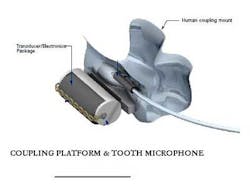ABSTRACT: Recording breath sounds with a novel tooth microphone
ABSTRACT
Mersky BL, Masri R, Tan K, Kempler J, Hwang-Lee H, Whitney JE. Audiodontics, Bethesda MD, Dental School, University of MD-Balto, Morgan State Univ, Balto MD.
Introduction: There are no electronic systems attachable to oral appliances that are capable of monitoring daily patient usage and the effectiveness of oral appliances as treatments for sleep apnea. A highly sensitive intraoral audio sensor (tooth microphone) when combined with pattern-recognition software could address this problem. An intraoral sensor (tooth microphone) system has been developed and tested for feasibility as a tool for recording the vibration of teeth and dental implants when the skull is stimulated by a bone conduction hearing aid or by speech and respiratory sounds. This tooth microphone hardware when attached to an oral appliance may function as the “front-end” of a system that can monitor sleep apnea treatment through audio recording of nighttime respiratory sounds.
RELATED |Screening for sleep disorders in the dental office: Better sleep for better health
Methods: Nineteensubjects were recruited who had a dental implant and an adjacent natural tooth under a testing protocol approved by the University of Maryland Baltimore Human Use Committee (HP-00042996). Acrylic holders with attached tooth microphones were custom fitted to teeth in either the maxilla or mandible. Testing proceeded with skull/tooth/implant stimulation with pure-tones generated by the audiometer (Beltone, Chicago, IL, portable audiometer) or with speech and breath sounds. Skull vibration (i.e., acceleration) was recorded with a sampling rate of 44.1 kHz and resolution of 16-bit data, and displayed by audio studio software (Audition; Adobe, San Jose, CA). Calibration of the tooth microphones was achieved by placing a calibrated B-71 bone oscillator on the forehead and matching signals in the software.
RELATED |You can do it! Oral sleep apnea therapy coded correctly
Results: The following were results from the study.
1. Tooth microphone was capable of recording low-amplitude vibration from mechanical stimulation of skull or tooth and from breath and speech
2. Inputting the same audio power into tooth and implant produced equivalent skull vibration
3. With stimulation from the bone oscillator placed on mastoid and:
• Two tooth microphones placed on opposite sides of maxilla, vibration attenuation was negligible (that is, no amplitude or phase differences)
• With one tooth microphone placed on maxilla and one on mandible, significant phase and amplitude differences were recorded
4. High frequency(> 1KHz) direct teeth stimulation resulted in high amplitude tooth microphone recordings, which implies an efficient transfer function
5. Natural speech produced greater vibration amplitude than did 60 dB HL stimulation from a tooth actuator
Conclusions: The study demonstrated:
- Natural teeth are equivalent to titanium implants as a skull stimulation sites
- Phase and amplitude differences exist between the maxilla and mandible and these differences may impact sound perception at a single cochlea
- The tooth microphone system has therapeutic, diagnostic, and commercial potential
Support: Support for the study was from the National Institute of Deafness and Communication Disorders (NIDCD), through the Small Business Innovative Research Program (SBIR/STTR) under Grant #1R41DC010082.


